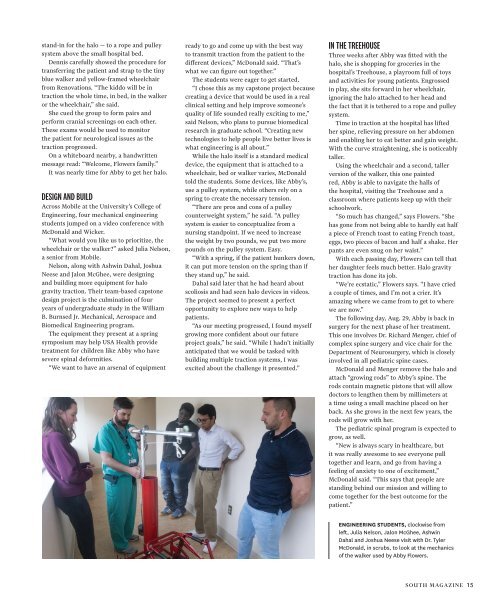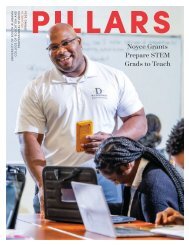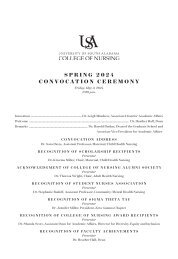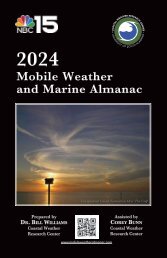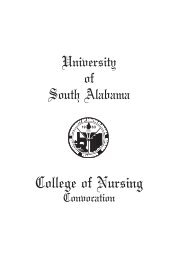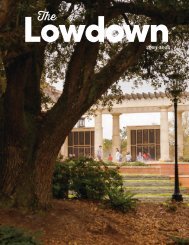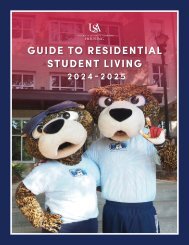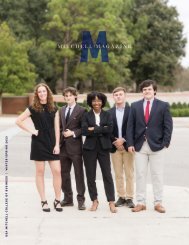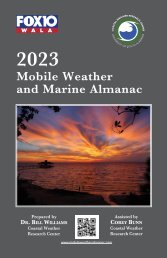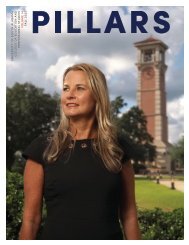South Magazine Fall 2023
Create successful ePaper yourself
Turn your PDF publications into a flip-book with our unique Google optimized e-Paper software.
stand-in for the halo — to a rope and pulley<br />
system above the small hospital bed.<br />
Dennis carefully showed the procedure for<br />
transferring the patient and strap to the tiny<br />
blue walker and yellow-framed wheelchair<br />
from Renovations. “The kiddo will be in<br />
traction the whole time, in bed, in the walker<br />
or the wheelchair,” she said.<br />
She cued the group to form pairs and<br />
perform cranial screenings on each other.<br />
These exams would be used to monitor<br />
the patient for neurological issues as the<br />
traction progressed.<br />
On a whiteboard nearby, a handwritten<br />
message read: “Welcome, Flowers family.”<br />
It was nearly time for Abby to get her halo.<br />
DESIGN AND BUILD<br />
Across Mobile at the University’s College of<br />
Engineering, four mechanical engineering<br />
students jumped on a video conference with<br />
McDonald and Wicker.<br />
“What would you like us to prioritize, the<br />
wheelchair or the walker?” asked Julia Nelson,<br />
a senior from Mobile.<br />
Nelson, along with Ashwin Dahal, Joshua<br />
Neese and Jalon McGhee, were designing<br />
and building more equipment for halo<br />
gravity traction. Their team-based capstone<br />
design project is the culmination of four<br />
years of undergraduate study in the William<br />
B. Burnsed Jr. Mechanical, Aerospace and<br />
Biomedical Engineering program.<br />
The equipment they present at a spring<br />
symposium may help USA Health provide<br />
treatment for children like Abby who have<br />
severe spinal deformities.<br />
“We want to have an arsenal of equipment<br />
ready to go and come up with the best way<br />
to transmit traction from the patient to the<br />
different devices,” McDonald said. “That’s<br />
what we can figure out together.”<br />
The students were eager to get started.<br />
“I chose this as my capstone project because<br />
creating a device that would be used in a real<br />
clinical setting and help improve someone’s<br />
quality of life sounded really exciting to me,”<br />
said Nelson, who plans to pursue biomedical<br />
research in graduate school. “Creating new<br />
technologies to help people live better lives is<br />
what engineering is all about.”<br />
While the halo itself is a standard medical<br />
device, the equipment that is attached to a<br />
wheelchair, bed or walker varies, McDonald<br />
told the students. Some devices, like Abby’s,<br />
use a pulley system, while others rely on a<br />
spring to create the necessary tension.<br />
“There are pros and cons of a pulley<br />
counterweight system,” he said. “A pulley<br />
system is easier to conceptualize from a<br />
nursing standpoint. If we need to increase<br />
the weight by two pounds, we put two more<br />
pounds on the pulley system. Easy.<br />
“With a spring, if the patient hunkers down,<br />
it can put more tension on the spring than if<br />
they stand up,” he said.<br />
Dahal said later that he had heard about<br />
scoliosis and had seen halo devices in videos.<br />
The project seemed to present a perfect<br />
opportunity to explore new ways to help<br />
patients.<br />
“As our meeting progressed, I found myself<br />
growing more confident about our future<br />
project goals,” he said. “While I hadn’t initially<br />
anticipated that we would be tasked with<br />
building multiple traction systems, I was<br />
excited about the challenge it presented.”<br />
IN THE TREEHOUSE<br />
Three weeks after Abby was fitted with the<br />
halo, she is shopping for groceries in the<br />
hospital’s Treehouse, a playroom full of toys<br />
and activities for young patients. Engrossed<br />
in play, she sits forward in her wheelchair,<br />
ignoring the halo attached to her head and<br />
the fact that it is tethered to a rope and pulley<br />
system.<br />
Time in traction at the hospital has lifted<br />
her spine, relieving pressure on her abdomen<br />
and enabling her to eat better and gain weight.<br />
With the curve straightening, she is noticeably<br />
taller.<br />
Using the wheelchair and a second, taller<br />
version of the walker, this one painted<br />
red, Abby is able to navigate the halls of<br />
the hospital, visiting the Treehouse and a<br />
classroom where patients keep up with their<br />
schoolwork.<br />
“So much has changed,” says Flowers. “She<br />
has gone from not being able to hardly eat half<br />
a piece of French toast to eating French toast,<br />
eggs, two pieces of bacon and half a shake. Her<br />
pants are even snug on her waist.”<br />
With each passing day, Flowers can tell that<br />
her daughter feels much better. Halo gravity<br />
traction has done its job.<br />
“We’re ecstatic,” Flowers says. “I have cried<br />
a couple of times, and I’m not a crier. It’s<br />
amazing where we came from to get to where<br />
we are now.”<br />
The following day, Aug. 29, Abby is back in<br />
surgery for the next phase of her treatment.<br />
This one involves Dr. Richard Menger, chief of<br />
complex spine surgery and vice chair for the<br />
Department of Neurosurgery, which is closely<br />
involved in all pediatric spine cases.<br />
McDonald and Menger remove the halo and<br />
attach “growing rods” to Abby’s spine. The<br />
rods contain magnetic pistons that will allow<br />
doctors to lengthen them by millimeters at<br />
a time using a small machine placed on her<br />
back. As she grows in the next few years, the<br />
rods will grow with her.<br />
The pediatric spinal program is expected to<br />
grow, as well.<br />
“New is always scary in healthcare, but<br />
it was really awesome to see everyone pull<br />
together and learn, and go from having a<br />
feeling of anxiety to one of excitement,”<br />
McDonald said. “This says that people are<br />
standing behind our mission and willing to<br />
come together for the best outcome for the<br />
patient.”<br />
ENGINEERING STUDENTS, clockwise from<br />
left, Julia Nelson, Jalon McGhee, Ashwin<br />
Dahal and Joshua Neese visit with Dr. Tyler<br />
McDonald, in scrubs, to look at the mechanics<br />
of the walker used by Abby Flowers.<br />
SOUTH MAGAZINE 15


